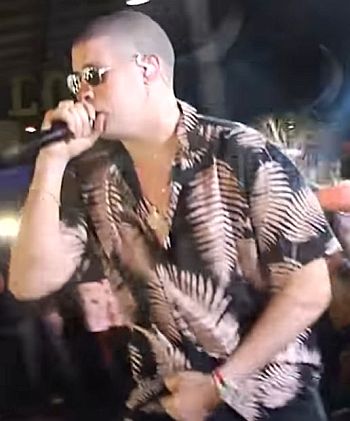Last Updated on April 6, 2025 by Bertrand Clarke
Benito Antonio Martínez Ocasio, the artist known globally as Bad Bunny, isn’t just a musician; he’s a cultural phenomenon. His story isn’t one of privilege or immediate access; it’s a testament to raw talent, relentless hard work, and an unwavering belief in oneself. This is the story of a kid from Vega Baja, Puerto Rico, who defied expectations and redefined the landscape of Latin music, inspiring millions along the way.
Humble Beginnings: A Foundation Built on Family and Music
Born on March 10, 1994, in the municipality of Vega Baja, Puerto Rico, Benito’s early life was rooted in the warmth and stability of a close-knit family. His mother, Lysaurie Ocasio, was a schoolteacher, instilling in him the importance of education and discipline. His father, Tito Martínez, worked as a truck driver, providing a strong example of dedication and hard work. Growing up with two younger brothers, Bernie and Bysael, Benito’s childhood was filled with the simple joys of a typical Puerto Rican family.
Music was always a constant presence. From a young age, Benito was captivated by the sounds of Latin rhythms, from salsa and merengue to the burgeoning genres of reggaeton and hip-hop. He would spend hours listening to legends like Daddy Yankee, Héctor Lavoe, and Vico C, absorbing their styles and dreaming of one day sharing his own voice with the world. He sang in the church choir until the age of 13, honing his vocal skills and developing a deep understanding of melody and harmony. This early exposure to different musical forms laid the foundation for his eclectic and genre-bending style that would later define his career.
While academics weren’t always his primary focus, Benito excelled in creative pursuits. He had a vivid imagination and a knack for storytelling, often writing his own songs and performing for his family and friends. These early performances, though informal, were crucial in building his confidence and solidifying his passion for music.
Facing Challenges: Balancing Dreams with Reality
Despite his artistic talents, Benito faced the same economic challenges as many young people in Puerto Rico. After graduating from high school, he enrolled at the University of Puerto Rico at Arecibo to study audiovisual communication. However, the demands of his studies, coupled with the need to support himself, made it difficult to fully pursue his musical aspirations.
To make ends meet, Benito worked as a bagger at a local grocery store. The long hours and monotonous tasks were a stark contrast to the creative freedom he craved. Yet, he never lost sight of his dream. Even while bagging groceries, he would hum melodies and jot down lyrics on scraps of paper, constantly refining his craft and seeking inspiration in the everyday lives of the people around him.
This period of struggle was pivotal in shaping Benito’s artistic identity. It instilled in him a deep sense of humility and a keen awareness of the social realities faced by many Puerto Ricans. These experiences would later inform his music, giving it a raw authenticity and a powerful message of social consciousness.
The Spark: Finding Inspiration and Defining a Sound
While working at the grocery store, Benito began experimenting with music production in his spare time. Using free software and readily available resources, he taught himself the basics of beat-making and recording. He started uploading his music to SoundCloud, a platform known for discovering emerging artists. It was here, under the moniker “Bad Bunny,” that he began to cultivate his unique sound.
His early tracks were raw and unpolished, but they possessed a distinctive energy and a captivating blend of trap, reggaeton, and Latin rhythms. He wasn’t afraid to experiment with unconventional sounds and lyrics, creating a style that was both familiar and refreshingly new.
Several artists inspired Bad Bunny, the legendary Vico C for his storytelling, Daddy Yankee, and Tego Calderon.
One key element that set Bad Bunny apart was his distinctive vocal delivery. His deep, raspy voice, combined with his laid-back flow, created a sound that was instantly recognizable. He also embraced a more introspective and emotional approach to songwriting, addressing themes of love, loss, and social injustice with honesty and vulnerability.
The Breakthrough: From SoundCloud to Global Stages
Bad Bunny’s breakthrough moment came in 2016 with the release of his track “Diles.” The song quickly gained traction on SoundCloud, racking up millions of plays and attracting the attention of DJ Luian, a prominent figure in the Latin music industry. Impressed by Bad Bunny’s talent and potential, DJ Luian signed him to his Hear This Music label.
“Diles” was officially released as a single, and it quickly became a viral hit, catapulting Bad Bunny into the mainstream. The song’s success opened doors for collaborations with established artists like Ozuna and Arcángel, further solidifying his position in the Latin music scene.
From that point onward, Bad Bunny’s rise was meteoric. He released a string of hit singles, including “Soy Peor,” “Krippy Kush,” and “Chambea,” each pushing the boundaries of Latin trap and cementing his status as a trendsetter.
Conquering the World: Chart-Topping Success and Cultural Impact
In 2018, Bad Bunny released his debut album, “X 100PRE,” which was a critical and commercial success. The album showcased his versatility as an artist, blending elements of trap, reggaeton, rock, and pop into a cohesive and compelling sound. “X 100PRE” debuted at number one on the Billboard Top Latin Albums chart, solidifying Bad Bunny’s position as a global superstar.
He followed up with a series of equally successful albums, including “Oasis” (a collaboration with J Balvin), “YHLQMDLG,” “El Último Tour Del Mundo,” and “Un Verano Sin Ti,” each breaking records and shattering expectations. “Un Verano Sin Ti,” released in 2022, became the first all-Spanish language album to top the Billboard 200 chart, a testament to Bad Bunny’s global appeal and the growing influence of Latin music.
Throughout his career, Bad Bunny has received numerous awards and accolades, including multiple Latin Grammy Awards, Billboard Music Awards, and American Music Awards. He has also been recognized for his cultural impact, using his platform to advocate for social justice and promote Puerto Rican culture.
More Than Music: Activism, Representation, and the Future
Bad Bunny’s influence extends far beyond the realm of music. He has become a powerful voice for social change, advocating for LGBTQ+ rights, gender equality, and the rights of marginalized communities. He has also been a vocal critic of political corruption and social injustice in Puerto Rico.
His performance on The Tonight Show Starring Jimmy Fallon wearing a skirt and shirt that read “They Killed Alexa, Not A Man With A Skirt” was a powerful statement denouncing violence against transgender people.
Bad Bunny’s success has also paved the way for other Latin artists to break into the mainstream. He has consistently used his platform to uplift and collaborate with emerging talent, creating opportunities for others to share their voices with the world.
Personal Life and Navigating Fame
Despite his global fame, Bad Bunny has remained grounded and committed to his roots. He maintains close relationships with his family and friends, and he continues to live in Puerto Rico, where he feels most connected to his culture and his community.
He is known for his authentic and down-to-earth personality, often interacting with fans on social media and using his platform to share glimpses of his personal life. He has also been open about his struggles with anxiety and the pressures of fame, demonstrating a vulnerability that resonates with his audience.
Bad Bunny’s relationship with Gabriela Berlingeri has been a subject of public interest. While they have maintained a relatively private relationship, they have often been seen together at events and on social media, showcasing a strong and supportive bond.
The Legacy: Inspiring a Generation
Bad Bunny’s story is more than just a tale of musical success; it’s an inspiration to a generation. He has shown that it’s possible to achieve your dreams, regardless of your background or circumstances. He has redefined the boundaries of Latin music, proving that authenticity and creativity can triumph over convention.
His journey from a grocery store bagger in Vega Baja to a global icon is a testament to the power of hard work, self-belief, and a deep connection to one’s roots. Bad Bunny’s legacy will continue to inspire aspiring artists and empower individuals to embrace their unique identities and pursue their passions with unwavering determination. He is a true original, a cultural force, and a symbol of hope for a generation that dares to dream big.









